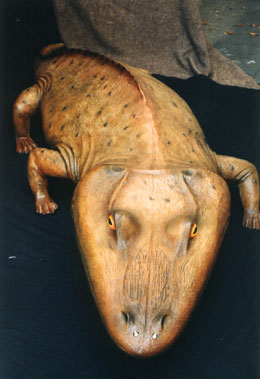 |
 |
 |
 |
 |
Produced
by the Population Genetics and Evolution class, Furman University |
||||
 |
 |
 |
 |
 |
Produced
by the Population Genetics and Evolution class, Furman University |
||||
 |
The
Triassic: Mastodonsaurus |
 |
||
| Mastodonsaurus
was a large temnospondyl amphibian that reached lengths of up to 6 meters
with a head that could reach a meter in length (Kazlev 2010, Zaurolandia
2010). Due to their almost exclusive aquatic lifestyle, their skeletons
became increasingly cartilaginous and their heads became very large and
flat. It is currently believed that due to its head size, the only way
to open its mouth would have been for the organism to tilt its head back
entirely (Kazlev 2010). Their jaws were characterized by uneven teeth
and well developed nasal apertures that could allow them to breathe air
while keeping most of their body submerged (Stow 1859). Interestingly
enough, it has been discovered that Mastodonsaurus possessed
sensory organs known as lateral line canals that would allow them to detect
water vibrations given off by other organisms. This feature is found in
many extant fish and reveals that Mastodonsaurus was well adapted
for survival in murky lakes and ponds (Zaurolandia 2010). Page by Iggy Gaska |
 |
| Mastodonsaurus. Picture From: palaeo-online. | |
|
Kazlev AM.2010. Temnospondyli: Overview.www.palaeos.com. Accessed May 23, 2010. Huxley TH. 1859. Some amphibian and reptilian remains from South Africa and Australia. Quarterly Journal of the Geological Society 15:642-649. Zaurolandia. 2010.Mastodonsaurus. Accessed March 23, 2010. |